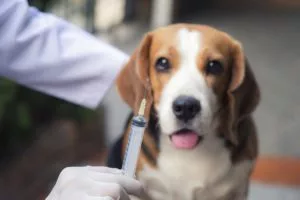Vaccinations Your Dog Needs in Warrick County, IN
Every dog needs to be vaccinated against deadly diseases. It is your job as a pet owner to make sure your dog has the proper vaccinations and know when they need to be done.
There are both core vaccines and non-core, or lifestyle vaccines that are required for each dog.

Core vaccines are required shots for every dog. Non-core vaccines, or lifestyle vaccines, are not required but recommended depending on the lifestyle and geography of the dog and also the nature of the disease. If your dog goes to doggy daycare, grooming facilities or a kennel or other facility, your dog will need these vaccines. A veterinarian can recommend which vaccines your dog needs and when to get them. Vaccines will help keep your dog safe and healthy.
There is a general consensus on which vaccines fall into the core category vs the non-core category and they are based on the risk factors of life stage of the dog and the lifestyle.
Here are the following core vaccines:
- Canine Distemper Virus
- Parvovirus
- Adenovirus (canine hepatitis)
- Canine Parainfluenza
- Rabies
In most states there are laws requiring a rabies vaccination. These laws vary across the United States and Canada by state and local jurisdictions.
Rabies is a required core vaccine. Most vets recommend an initial dose in puppies at 16 weeks of age and no earlier than 12 weeks of age. A rabies booster shot is required at one year of the initial dose and some states give a dose at three years of age. Some states only recognize the three year dose, it varies from state to state. Your veterinarian will know what is required based on the state you live in.
A combination shot is usually given for Distemper, Parvo, Adenovirus and Parainfluenza. This combination vaccine usually starts with puppies as young as six weeks in age for Distemper and Parvo. The combination shot of all four vaccines is usually given at 10-12 weeks of age with boosters to follow every 2-4 weeks until the puppy is 16 weeks of age. If your pet lives in a high risk environment, the vet usually recommends a final dose at 18-20 weeks of age. These are areas that distemper and parvo are prevalent or your puppy is around other dogs and potentially contaminated environments. A one year booster shot will need to be given and then at 1-3 year intervals after that.
There are certain cases in which vaccines will not be given if your dog has certain health issues and it would be harmful to the pet if administered. Your veterinarian would have to access each case individually and diagnose that pet as having a high-risk for not giving the vaccine.
Non-Core vaccines are not required by law but usually given and administered as it keeps the dog healthy and safe. These vaccines are based on lifestyle and location. Does your dog travel? What are the prevalent local diseases for dogs in your area? Does your dog go to dog parks? Boarding kennels? Daycare? If so, your dog will need these non-core vaccines.
Here are the following non-core vaccines and when they are administered:
Bordetella, Bronchiseptica and Canine Parainfluenza Virus
The vaccine is typically administered into the nose with a spray when the puppy is between 8 and 16 weeks of age. Immunity generally lasts 12-14 months.
Leptospira
This is a bacteria found in standing water and mud and can cause liver and kidney damage. If your dog is at risk, your vet will recommend an initial vaccination and annual revaccination.
Borrelia burgdorferi (Lyme disease)
Dogs living in or traveling into Lyme-disease-endemic areas are at increased risk for exposure and infection. The ticks that carry Lyme disease are especially likely to be found in tall grasses, thick brush, marshes, and woods. If a vaccine is indicated for travel, two doses should be administered, 2-to-4 weeks apart, so that the last dose is approximately 2-to-4 weeks before travel.
Canine Influenza Virus-H3N8
This vaccine should only be administered to dogs with a defined risk for exposure to this virus, such as those frequenting grooming facilities, day care, dog parks, competitive events, and places where exposure to other dogs is common. The first dose of the vaccine may be administered to dogs 6-to-8 weeks old and a second dose follows, 2-to-4 weeks later. If there’s continued risk of exposure, a booster should follow within one year.
Canine Influenza Virus-H3N2
Like the previous influenza vaccine, this should only be given if there’s potential exposure to the virus. The initial vaccine can be given to dogs younger than 16 weeks old and as young as 6-to-8 weeks. It’s administered in two doses, 2-to-4 weeks apart. If there’s sustained risk, revaccination is administered within one year. The AAHA recommends that any dog considered at risk should be vaccinated against both strains of the virus. Vaccinated dogs may still become infected following exposure, develop mild clinical signs, and transiently shed virulent virus and be contagious.
Just remember that vaccines come in core and non-core vaccines. Most vaccines start when a puppy is as little as four weeks of age and continue until the dog is clearly an adult, at one to three years of age. In many states, vaccines are required by law especially rabies. Rabies is the single vaccine that is required to be administered by a registered veterinarian. Non-core vaccines, while not required by law, are usually administered based on the lifestyle and location of the dog. If you have any questions, call Warrick Veterinary Clinic in Newburgh at (812) 853-6041 or Boonville at (812) 897-4855.
